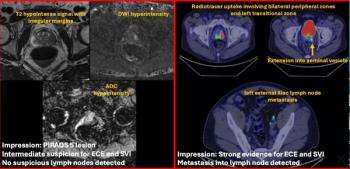
Toshiba readies 3T offering for RSNA meeting
Toshiba's first 3T scanner is set to debut at the RSNA meeting. The prototype exhibit will not only offer a first glimpse of the new technology, it will also serve as a signal that the Japanese company plans to become a player in the high-end MR market.
Toshiba's first 3T scanner is set to debut at the RSNA meeting. The prototype exhibit will not only offer a first glimpse of the new technology, it will also serve as a signal that the Japanese company plans to become a player in the high-end MR market.
Bob Giegerich, director of Toshiba's MR business unit, noted that the 3T system is a long way from entering commercial production, but its presence in the Toshiba booth will give prospective buyers of MR scanners a heads up that the company should be considered in the future.
"We are serious about the MR market and we are making the investment," he said.
The compact magnet will feature very high homogeneity, Giegerich said. The company has not publicly released information about the manufacturer, but it may do so at the RSNA meeting.
Engineering challenges remain, he said. One, which is inherent to all 3T scanners, is noise. This will be addressed by the company's Pianissimo technology, which has been applied successfully to scanners of lesser field strength.
In addition to the 3T prototype, Toshiba will show an advanced version of its 1.5T Vantage platform. The Vantage Atlas will support whole diffusion-weighted imaging, a capability dubbed BodyVision that produces a high-resolution map of the body. Atlas will also incorporate noncontrast-enhanced imaging, as well as high-resolution breast imaging, both of which Toshiba has developed and features on its other Vantage platform.
Like its predecessor, Atlas will be configurable with two different gradients, the "X," which generates amplitude of 30 mT/m and a slew rate of 130 mT/m/sec; and the "Z," which generates amplitude of 33 mT/m and a slew rate of 200 mT/m/sec. The new platform, Atlas Z, will have the horsepower to run cardiac exams.
Toshiba strategists see high-field imaging as the indisputable future of MR scanning, noting the demise of the midfield open market in the U.S. as a harbinger. Declining demand has led the company to begin phasing out its Ultra and Opart 0.35T open scanners.
"It's a shame, as they were great products," he said. "The market has just dried up."
Newsletter
Stay at the forefront of radiology with the Diagnostic Imaging newsletter, delivering the latest news, clinical insights, and imaging advancements for today’s radiologists.




























